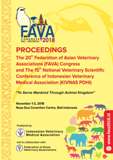PCS-4 In Vivo Embryo Production at Cipelang Livestock Embryo Centre
Abstract
Livestock Embryo Center/Balai Embrio Ternak (BET) Cipelang is one of the government institution under the supervision of Directorate General of Livestock and Animal Health Services, Ministry of Agriculture of the Republic of Indonesia. BET Cipelang has the main task of carrying out the production, development, and distribution of livestock embryo for all regions of Indonesia. BET Cipelang produced embryos using two methods, there are in vivo and in vitro. The produced embryos will be transferred to the recipient cow using embryo transfer technique.
Embryo transfer biotechnology can be used to enhance genetic improvement and to increase marketing opportunities with purebred cattle. Because of their relatively low reproductive rate and long generation interval, embryo transfer is especially useful with cattle. The success of embryo transfer depends on factors associated with the embryo, the recipient or an interaction among the factors of the embryo and recipient [1].
Embryo quality is one of the main factors for successful embryo production. In vivo embryo production has better quality than in vitro such as cell number, morphology, growth and development ability and after freezing. The frequency of occurrence of chromosomal abnormalities in in vivo-derived embryos are lower than in vitro and the consequence is that only 30-40% of oocytes resulting from in vitro maturation develop into blastocysts after in vitro fertilization and the in vitro yield rate of embryos are lower than from in vivo [2]. Recently, there are no studies about the performance of in vivo embryo production at BET Cipelang. The aim of this study is to explore the quality of in vivo embryos produced by BET Cipelang.

